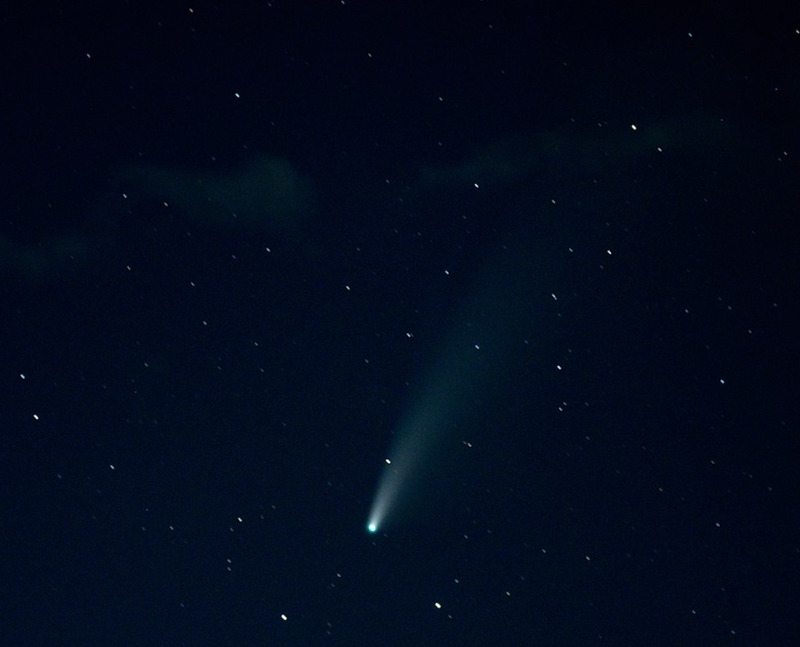Ungulate Highways
In Search of Mountain Caribou
by Jack Kredell
I.
I’ve never really felt at home in the human world. As a child, I preferred the company of insects and alligator lizards, the latter of which I plucked unsuspecting from sunwarmed pavers in San Fernando Valley backyards. If I was too slow and happened to pin the lizard by the tail, the tail would often be jettisoned and left witching under my fingers as the lizard scurried to safety. I buried the tails, sometimes still twitching, in the soft dirt of my father’s rose garden, as I was unsure if a new tail grew from the old lizard or a new lizard from the old tail.
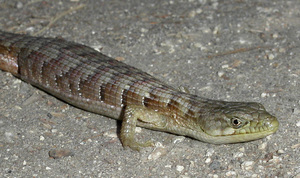
Arise Lazarus!
When I discovered giant squid in a picture book about sharks and whales, I asked my mom if there were giant squid in the ocean right now.
“Yes, right at this very moment,” she said.
Astonished and pleased by the mere fact of their existence, I disappeared into my room to play with my dinosaur figurines or plunge into a volume from the complete Illustrated Encyclopedia of the Animal Kingdom.Illustrated Encyclopedia of the Animal Kingdom. They were the only books that held my attention as a child. The volume on scorpions had become so tattered by my grasping, abusive style of reading that the binding had disintegrated, leaving a stack of loose arachnids that I continued to pore over and reshuffle without regard for pagination. If too much time had passed since the confirmation of the existence of giant squid, I would locate my mom and ask her once again:
“Are there giant squid in the ocean right now?”
“Yes, right at this very moment,” she repeated.
But my fascination with nonhumans, in particular with those who are extinct or out of reach—dinosaurs or abyss-dwelling giant squid—reached a formative fever pitch when I encountered a being who, until that moment, was known to me only from the pages of my encyclopedia and the museum. Early one morning I was awoken by my dad who carried me, still half asleep, to the bay window in the living room and whispered, “Look.”
All I saw was a blur of glaring light as I wiped the sleep from my eyes. Drenched earlier by my dad’s ritual dawn watering, the grass blazed and shimmered in the early morning sun. Slowly, the front yard took on its familiar shapes—the two sycamores with their fuzzy leaves and pastel trunks, the hedge with its multitudinous clusters of white, bee-charming flowers. Then I froze (in some far-off world, I am still holding that breath): a long brown neck bent gracefully toward an island of dandelions. An animal—a deer. A deer was standing in the front yard of our suburban San Fernando Valley home.
It was my first time seeing a deer—real megafauna—outside the articulated skeletons dredged up from the La Brea Tar Pits on display at the Natural History Museum of Los Angeles County. My pulse quickened and the body ached to get closer. Wanting to see it without the dark-tinted mesh of the window screen, I ran to the front door and stuck a hand through the mail slot to lift the faux-brass door, but as I did, the hinge creaked and the deer bobbed its head, spun, and bounded away up the street. As much of me died in that instant of departure as was made alive by the arrival—my earliest memory.
And I say “bounded away up the street” but I don’t know where the animal actually went. It simply disappeared into the landscape as only deer and other ungulates can. They ghost. They get on their ghost highways and vanish. I wanted to get in the car and drive after it, but my dad was late for work. In the aftermath of the encounter I kept trying to picture to myself, or map, the route the deer may have taken to get from the foothills (some two miles away) to our yard, a journey that required a number of busy street crossings, including one four-lane boulevard. Though suburban deer aren’t too uncommon, to the child it was a miracle.
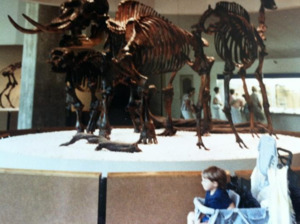
As is often the case with memory, the image of the deer grew suspect over the years. When I picture the scene now, some thirty years later, I see a white-tailed deer standing over the clump of dandelions. But the original deer would have been a California mule deer, a smaller subspecies of western mule deer adapted to California oak savannah and chaparral. And it’s unlikely the neck was brown or chestnut like a white-tail’s, probably more of a mule deer’s taupe with a hint of blue. Over time, the mule deer was erased, subtly and imperceptibly, by my family’s move to rural Pennsylvania when I was a teenager, where my relationship to white-tailed deer, as a hunter, took on a different hue entirely. I’ve replayed the episode of my dad waking me to see the deer countless times in my head—it is one of the stories I associate with the San Fernando Valley, and yet, it is just as much a story about a different time and place, infused by the years of stalking white-tailed deer in the hardwood forests of central Pennsylvania. In that encounter with the deer I was seized. “As we are seized,” write Thom van Dooren and Deborah Bird Rose in “Lively Ethography,” an essay central to this project’s theoretical framework, “so we bear witness in order that others may be seized: telling stories that draw their audiences into others’ lives in new and consequential ways, stories that cultivate the capacity for response.”2Thom Van Dooren and Deborah Bird Rose, “Lively Ethography,” in Environmental Humanities: Voices from the Anthropocene. Rowman and Littlefield, 2017, pp. 255-271. The encounter with the deer is the story of my becoming seized, of bearing witness to a shared world; it is simultaneously the response, unfolding over my lifetime from that moment until now, of ungulate dreams.
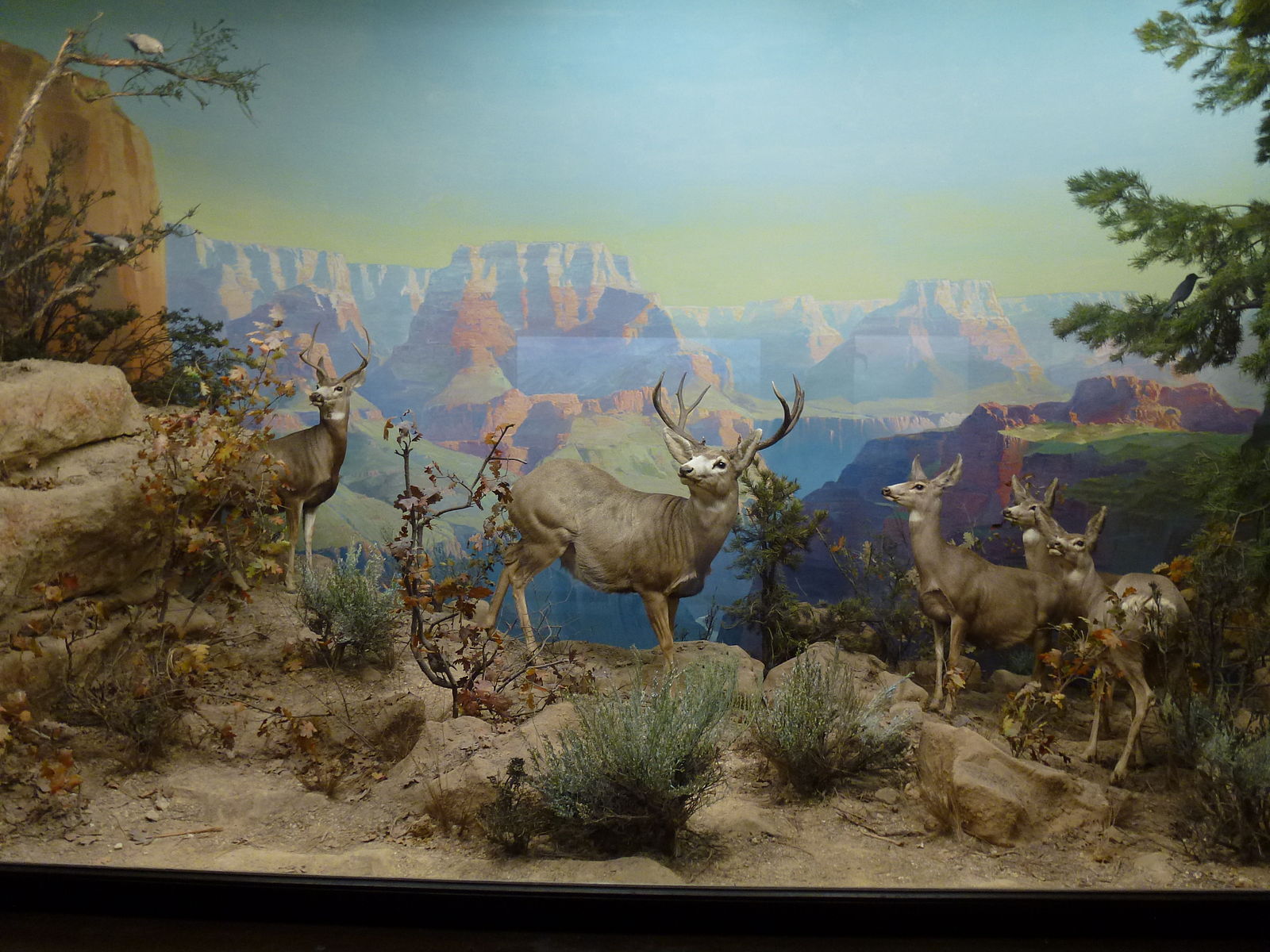
II.
I first heard of South Selkirk mountain caribou while driving from New York City to Idaho in search of a different ungulate—elk. I had a nonresident archery elk tag in my pocket and was going to try to fill it while visiting my grandmother in Donnelly, Idaho. It was late in the summer of 2016 and I had just quit my job of three and a half years at a tech startup, a job which, in addition to low pay, had given me chronic lower back pain but no health insurance or time off to fix it. I didn’t know or care what was next. I just knew I needed a month, at least, of climbing mountains, grand views, shitty coffee, pumping gas, freeze dried meals, cold nights, tired legs, missing home, and not standing in crowded subway cars full of bruised angry rundowns like myself. Most of all, I needed time off from sitting. The irony wasn’t lost on me either: I would spend the next five days in the driver’s seat.
I was a deer hunter and didn’t know the first thing about elk hunting, but it didn’t matter because I was on the ungulate highway. War Pig, my snotgreen 1998 Jeep Grand Cherokee, was driving straight for once and ticking off the miles as we entered a stretch of I-80 West on the Allegheny plateau that unfurled like a skybridge over unbroken oak canopy stretching as far as the eye could see. And somewhere under that canopy moved the descendants of 177 elk transported by railway from Montana and Wyoming between the years of 1913 and 1926.

Though I prefer to think of these elk as belonging to the Greater Yellowstone elk diaspora (50 of Pennsylvania’s elk came from Yellowstone), I once had an encounter with a young bull elk on Young Woman’s Creek, near the town of Renovo, in which I squinted and tried to pretend I was looking at an Eastern elk—the extinct though morphologically identical subspecies, or ecotype, that once roamed the vast hardwood forests of the northeast (it might’ve worked had it not been for the large radio collar). But the elk were back, or at least a facsimile edition of their work, and for that brief moment on the ungulate highway, surrounded by a sea of green forest, I felt like that apocryphal pre-Columbian squirrel that could travel from Maine to Florida on the primeval hardwood highway without ever touching the ground. And then I got to Ohio.
Playing through the car’s stereo was a hunting podcast in which the episode’s guest, Bart George, a wildlife biologist for the Kalispell Tribe, was discussing the tribe’s effort to save the South Selkirk mountain caribou herd, then estimated to be less than fifteen individuals. Despite the alarming precarity of their situation, I was awestruck by the thought of actually existing caribou in Idaho and Washington. Again, I felt a ‘becoming seized’ by caribou and their otherness with respect to the ungulate scene of the United States—deer, sheep, moose, mountain goats, pronghorn, elk. The thought of caribou took me to another era—the Pleistocene Ice Age of my beloved La Brea Tar Pits—where, as a child, I longed to be among its extinct dire wolves, short-faced bears, and saber-toothed cats. I came to think of mountain caribou as an ice age phantom, a relic, a ghostly projection from the ancestral Cordilleran ice sheet. Part living, part dead. And in fact, the continent was already full of their ghosts; the recent extirpation of mountain caribou wasn’t a first for caribou in the history of the United States. We were witnessing a second death.
Until the mid-nineteenth century, woodland caribou, a boreal forest-dwelling subspecies of North American caribou (Rangifer tarandus), ranged as far south as Minnesota, Wisconsin, Michigan and New England. Unlike their migratory arctic cousins, the barren-ground caribou, these were mostly sedentary animals who for millennia lived and died in the coniferous snow forests of the northern United States. Today, certain Northeastern toponymies bear witness to woodland ghosts: Maine’s Caribou-Speckled Mountain Wilderness, for example, so named after two brothers who shot and killed the area’s last caribou in 1854. With the exception of a few individuals spotted in northeastern Minnesota during an aerial survey in winter of 1980-81, woodland caribou were all but eliminated from their ranges in the contiguous United States by the start of the 20th century. However, an ecotype of the woodland caribou, the southern mountain or “black” caribou—a reference to their dark and shadowy appearance, and the preferred nomenclature of Idaho game warden and conservationist Paul Flinn, an early advocate of the Lower-48’s last native caribou herd—were still the occupants, though tenuous and beleaguered, of the northern tip of Idaho’s rugged Selkirk Mountains as recently as 2019.
The mountain group was able to outlast its woodland relatives by, in a sense, migrating annually to the arctic; a migration not to colder latitudes of the Far North, but to colder altitudes in the South Selkirks of Idaho and Washington. Here and in other ranges where they were historically found—the Purcells and Cabinets, to some extent the Bitterroots—mountain caribou adapted to a life of wintry high-country solitude, relying on the spatial separation that such inhospitable country provides from predators—humans or otherwise. And now, due to a combination of factors including historic 20th century fires, extractive industries (logging, mining) and their infrastructures, development, and an increased load of winter recreation, the arctic oasis of the South Selkirk mountains had shrunk to the point of no return, and with it went the mountain caribou.
In the Spring of 2019 news broke that the remaining three individuals of the South Selkirk herd had been airlifted to a captive breeding facility in southern British Columbia, leaving them functionally extinct. That fall I entered grad school at the University of Idaho where I began asking myself a set of questions: What was their story, I wondered, and how does one even begin to the tell the story of extinction? What does their extinction mean to us? What does it mean to the people who knew them through their encounters?
III.
Do you have an Idaho caribou story?
We are a pair of University of Idaho graduate students currently at work on a research project about the recent loss of North Idaho’s South Selkirk mountain caribou herd. We will be traveling to the South Selkirk Mountains and surrounding communities to gather ecological, historical, graphic, and geographical data that will be incorporated into a web-based deep map (multilayered interactive map) documenting ecological/community response to mountain caribou absence in North Idaho. A key component of this project is the collection of oral history from communities surrounding this area, and we are seeking volunteers who have stories pertaining to caribou for incorporation into the project.
If you have a story about a caribou encounter (or anything pertaining to the former Idaho Mountain Caribou herd) that you would like to share, please send e-mails to Jack Kredell _jkredell@uidaho.edu_) and/or Chris Lamb (_clamb@uidaho.edu_).
It was the moment of truth, a wordy one at that: We were about to find out if stories of mountain caribou encounters—the “key component” of our grant-funded project—exist in any real number to begin with (if they exist at all). It hadn’t really occurred to us until now, with the publication of our notice in the Spokane Spokesman Review, that the idea behind project was an educated guess: 20-30 individuals with mountain caribou stories from the 1990s or earlier, before the herd’s complete collapse. Added to this uncertainty is the fact that their stories aren’t just sitting out there like apples on a tree, ripe for the picking; caribou stories are out running around as people—busy, bothersome people. Most of our subjects will be older. And the majority of our would-be subjects are already dead, leaving behind caribou stories I can only dream of. The reality of it was nauseating.
I heard the chime of sent email and my colleague and partner on the project, Chris Lamb, looked up from his laptop and announced that it was “done.” A fundamental part of the project was now out of our control, possibly forever. I thought about telling him this, but I already knew what he’d say: it never was. Idaho’s caribou were exposed to the world, too, and now they’ve become never was.
“But suppose nobody emails us—what then?”
“Well then we’re fucked.”
But we were not fucked: A week after publishing our call for caribou stories in the Spokesman-Review we got a terse email from somebody named Bob Case:
On June 14, 2020, at 2:56 PM, Bob Case wrote:
I have pictures of a caribou encounter.
Sent from my Samsung Galaxy , an AT&T LTE smartphone
We had already received several emails from people who had photographs of caribou which turned out to be press clippings from the herd augmentation efforts of 1980s. These were interesting in themselves but not the encounter stories we hoped to solicit. Intrigued as we were by Bob’s email, the phrasing made us uncertain as to whether the photos were of his own encounter or somebody else’s. Still, we figured it was worth the 90-minute drive to Spokane to find out and offered to meet the following Monday morning. At worst we’d get more press clippings. But then, two days later, we got a strange email from Bob in which he admitted to driving to Moscow from Spokane earlier in the day, seemingly for pleasure, and without advance warning:
On Jun 16, 2020, at 9:43 PM, Bob Case wrote:
I should have told you I work nights. Early hours are hard for me.I usually get up at that time.I took a drive down there today after my doctor appointment. It was a nice drive.
Sent from my Samsung Galaxy , an AT&T LTE smartphone
We were beginning losing faith in Bob but decided to reschedule for the 29th, in Moscow, at the University of Idaho rec center parking lot. About an hour before the interview Bob called to tell us he was an hour away. During the phone conversation between Bob and Chris, I got the impression there might yet be another wrinkle in the saga based on how Chris was straining to understand Bob. When I asked about it Chris shrugged his shoulders and said, with some uncertainty, “his voice.”
It’s starting to drizzle when Bob pulls up in a navy-blue Subaru Baja. He’s short, middle-aged, and wearing a pair of dark sunglasses though the day is thoroughly overcast. He greets us in a strained, screechy kind of whisper, painful seeming, which he informs us is due to a chronic condition called laryngeal dystonia in which muscle spasm prevents the voice box from operating properly. In order to speak, Bob has to consciously manipulate his lower diaphragm and abdominal muscles via contraction to produce the hoarse whisper that carries speech where over-tightened vocal cords cannot. But it’s apparent right away that Bob loves to chat; in fact, he’s something of a virtuoso of diaphragmic ventriloquism, conversing in a way as dexterous as it seems painful.
Without missing a beat, and like some old-fashioned gumshoe, Bob unwinds the string fastener on a manilla envelope and begins to narrate as he places a half dozen original photographs of a large mountain caribou, a bull, on the bed cover of his Baja. Despite having used a miniature format 110 camera, the pictures of the massive radio-collared bull standing broadside in a Selkirk boulder field are otherworldly and communicate both a sense of proximity and respectful distance with the animal. The story Bob is telling is so captivating, and yet to us so physically painful, that neither Chris nor I have the heart to stop him to ask permission to attach a Lavalier mic to his collar so we can begin recording. There’s a moment of lull in the conversation and I ask if we can record him. But Bob frowns to show his reluctance, before launching into yet another Selkirk adventure, of which there are ample reserves: Bob is a committed hiker who has done all but two hikes in Rich Landers’ regional classic 100 Hikes in the Inland Northwest. As Bob continues to talk, despite his own self-imposed restrictions on talking too long, Chris and I share a rueful, helpless glance not knowing how to capture Bob’s fleeting and hoarse birdsong. So I switch tactics. I tell Bob that his story and pictures are fantastic, that we’re available to drive to Spokane on a day of his choosing, a day when he hasn’t talked this much. It would only take a few minutes. The whole thing, I tell Bob, would take less than fifteen minutes. And now Bob is softening up. He says we can probably do it now. We ask Bob to tell his caribou story once again, the hike he took to Chimney Rock, just as he had the last three times. We attach the Lavalier mic to his collar, turn on our camera, and witness as Bob sings:
“I’m Bob Case and I took a hike up to Chimney Rock. I want to say it was either 93’, maybe up to 95’—somewhere in there. And when I went up over this ridge, an open rock field, which you can see right in here [points to his photograph of the caribou in a rock field], I came down, I was walking down and then this caribou stood up. Well the people told me about being careful with the encounters with the different animals that could charge ya, and I said, well, they never told me about this [points demonstrably to caribou photo]—what this could do. So I stood there and looked for an area where I could dive under the rocks to protect myself and got my camera out and started taking pictures. Then the caribou got up and it walked around just like this [now Bob is doing something with his hands that reminds me of an orbital model of the earth and moon. Bob and caribou are celestial bodies at this point, orbiting one another in the shared gravity of encounter] and it got closer and closer as it walked. When it got here, I believe it got the smell of me with the wind blowing and then it just walked off. So that was my day and I got to see a caribou and I been hiking ever since because that was the biggest thrill ever since I been hiking here.”
Afterwards, I wasn’t sure if Bob had encountered a caribou or if a caribou had encountered Bob. Later in the summer we will spend time with a subject who spent a decade trying to get a glimpse of a mountain caribou in the wild, without success; and here is Bob, the translocated Bostonian, wondering if he should dive under the rocks to avoid the charge of a radio-collared and translocated bull caribou, at the time the most critically endangered mammal in North America. In the video, Bob appears to get emotional during the last sentence. As he says, the encounter that day with a radio-collared bull caribou “was the biggest thrill ever since I been hiking here.” This statement has always resonated with me, not only because of the significance of the encounter for him personally, but his complete lack of interest in the radio-collar and the politics surrounding the herd augmentation effort. For Bob, it was an encounter with something magnificent that could “charge ya” (Bob’s variation on van Dooren and Rose’s “seized”) which happened to be a mountain caribou.
His encounter story is a bearing witness to caribou, which are now absent from Idaho, but it is also a bearing witness to ourselves in terms of asking what world we choose to inhabit. Do we want to live in a world in which “this“—Bob’s word for caribou because miracles do not possess taxonomies—cannot seize us in some alpine boulder field? Cannot make us want to dive under the rocks when faced with its nameless and terrifying beauty? Do we want to live in a world in which a deer can’t walk out of the pages of a child’s tattered encyclopedia? I am that child and because of that deer I now walk the ungulate highways in search of caribou ghosts.
I feel a strong kinship to Bob. As a child, I had an uncontrollable stutter that caused my voice to seize and trip over itself, making it uncomfortable to talk. So I avoided people and instead sought the company of animals who relieved me from the burden of speech. They were gracious and let me practice my solitude beside them. And in that shared space I learned to sing with them, for an animal is a song, a specific reverberation of space and time that echoes and harmonizes across “countless interwoven ēthea that together comprise the foundation of our worlds” (263). When the hinge creaks or they get wind of you the song usually stops, but a stop is not an ending. I am beginning to think the song of mountain caribou has ended, or is in the process of being forgotten. Extinction is a kind of forgetting.
IV.
Whenever I meet somebody who has encountered mountain caribou in the South Selkirk mountains of the United States, I feel as Roland Barthes once did upon discovering an early photograph of Napoleon’s younger brother, Jerome:
And I realized then, with an amazement I have not been able to lessen since: “I am looking at eyes that looked at the Emperor.” Sometimes I would mention this amazement, but since no one seemed to share it, nor even to understand it (life consists of these little touches of solitude), I forgot about it.
While sitting face to face with an interview subject, I often think how I am looking at eyes onto whose retina appeared, inverted, the image of a real mountain caribou, a physical trace of which now exists in their brain as the encounter’s dendritic signature. And as they talk, I feel the image of the mountain caribou migrating (or maybe it is the mountain caribou) from their brain to my own, from their solitude to mine. Barthes’s line about “little touches of solitude” has always resonated with me, hauntingly at times. I take Barthes to mean that, often, we are unable to communicate or share the very thing that moves and defines us in our core being with other people. Chris has many “little touches of solitude” about him, and I feel we are drawn to each other because of a mutual familiarity with the solitude of being unable to share something. While different from my own kind of solitude, Chris, a former professional ski jumper, has spent most of life dedicated to the pursuit of a sublime kind of solitude—the perfection of human flight—which, like my need to feel the presence of giant squid, is also difficult to make others understand. And maybe I enjoy his company because he is part animal—part bird.
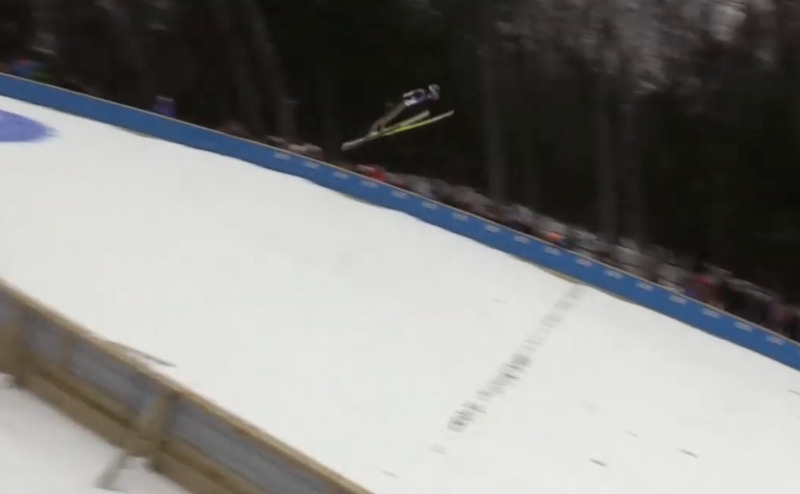
A few days after meeting up with Bob Case we received an email from a man named Dave Boswell. Like Bob’s, the message was circumspect but pointed. I half expected it to self-destruct after reading:
Greetings,
I may have some information relevant to your caribou research project.
Don’t hesitate to contact me.
Dave Boswell
I didn’t hesitate but the call went straight to voicemail. A few hours later, while eating Chinese take-out, I got a call from a Spokane number:
“Hi, is this Dave?”
“Are you the caribou guy? Which one are you?”
“I’m Jack.”
“Well nice to you meet you, Jack. My name is Dave Boswell. So you guys are putting together some kind of project about mountain caribou?”
I tell him about the project. How we are building a digital deep map; a multimodal and interactive spatial narrative about caribou loss told through video and audio interviews, ecology, photography, and getting ourselves lost in the woods. The loss of a species is the loss of a world; a world that is mappable in so far as it is understood to be lost. We were going to map their absence. Gone is the starting point.
“Are you guys natural resource majors?”
“No, English.”
“Well shit that’s weird. Have you ever heard of the Jeannot Caribou? It was shot by Jean Jeannot in 1892 and the mount was exhibited in the 1893 world’s fair wherever it was that year.”
“Chicago?”
My dad collected antique paper weights. I have a small bronze weight of the Chicago skyline from the World’s Columbian Exposition, also known as the world’s fair, that was held in Chicago in 1893 to commemorate the 400th anniversary of the arrival of Columbus—a date that proved fateful for America’s caribou.
“Well it was the largest black caribou ever shot in the state of Idaho—I use the term black caribou on account of their dark coloration. Have you read Paul Flinn’s book? He says they were almost black and damn near invisible when they got into the dark timber. I may have a copy if you need one. Of course, you need to read the Klockmann Diary for the story of Bill Houston.”
“Long story short, I found two caribou mounts at a hotel saloon in Hope, Idaho and bought them. The smaller one I gave to the biologist Don Johnson at the University of Idaho. He wanted the jawbone for something. He measured the Jeannot caribou and said it was the largest specimen he’d ever seen. Hold your arms out wide as you can. That’s how big it was.”
I had a vision of filming Dave sitting by the fireplace with a glass of merlot, the Jeannot caribou mount resting beside him, telling the story of how he, against all odds, rescued the internationally famous Jeannot caribou from Hope, Idaho. I asked him if we could come see the mount and get his story on camera.
“It’s in the basement at my place near Priest River. But it’s a sad story. Some teens broke into my cabin a while back and stole the antlers. Stole some other stuff too.”
“They sawed them off?”
“No, they used a fire poker to hack them off. You guys want to come spend the night at the cabin?”
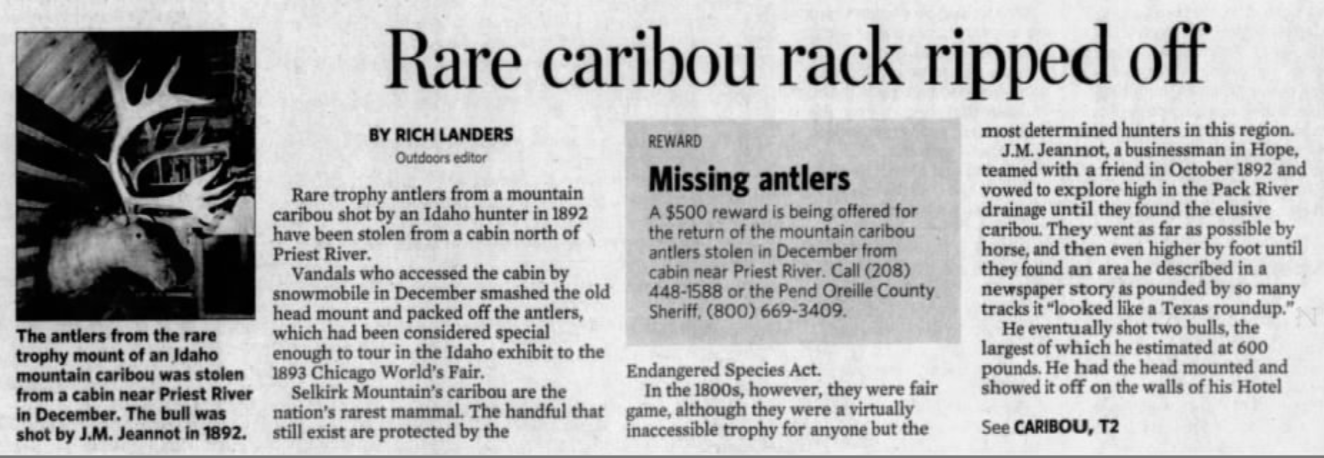
I immediately call Chris to tell him about the enigmatic caribou aficionado named Dave Boswell—he became ‘Boswell’ or ‘Bozzie’ thereafter—who invited us to spend the night at his cabin in order to see the world famous Jeannot caribou which, unfortunately, had been mutilated by teenagers and was now kept in his basement. Gripped by empathy for Dave, I tell Chris to hold out his arms as wide as he can because that’s how big the Jeannot caribou’s antlers were. Chris agrees without hesitation to spend the night at Dave’s remote cabin. The risk of visiting a stranger’s remote basement be damned. In the weeks leading up to our visit, Dave becomes something of a mythic figure to us—a true disciple of the gray ghost, a mountain hermit who wandered the Selkirk wilderness for a decade only to fall short of glimpsing his idol. The closest he got was a set of tracks at a place called Goblin Knob.
There were two instances in the summer of 2020 where the phenomenon known as precognition occurred. Late in the spring before our notice was sent out, I told Chris that I had a mental image of a caribou mount in somebody’s basement in North Idaho. It turned out to be Dave Boswell’s basement, which was technically in Washington, but I was close. The other moment occurred when Chris had a dream of the three of us—the third member of our expedition party being North Idaho cultural ambassador Michael Decker—fleeing a mountain from some unseen and implacable force. The force turned out to be our own stupidity mixed with hypothermia, which forced us to abandon our camp near Little Snowy Top Mountain and hike out twelve miles in the dark over Shedroof Mountain on unstable snowpack.
V.
We were somewhere near the Washington-Idaho border, in a large oval swath of Kaniksu National Forest encircled by Highway 57 to the east and Priest River to the west. The ranch was located in an area called “Bear Paw,” which, as Dave would later explain, got its name from the West Branch of Priest River’s local tributaries, which branch off in the shape of a bear’s paw. We had reached the end of our directions, hastily scrawled on the envelope resting on my thigh: “take Bear Paw Rd until you see all the mailboxes, then drive about six miles until road on right.” We were more than six miles past the mailboxes and still without a turnoff. Cell service ended an hour ago. We were now trapped in Bear Paw’s dusty creases between walls of black timber, which felt like they were closing in on us. We pull off the road to take a leak and reconnoiter. I walk deeper into the woods than privacy necessitates, as I tend to do, in the hope of coming across an animal or edible mushroom. I think about telling Chris that we should give up, find a place to camp, and go fishing. On my way back I notice a bolete shouldering its way through a cake of bronze needles. As I bend down for a closer look, I see Chris looking through his binoculars back in the direction we came from.
“What is it?”
“A bear. Little black bear. Way down the road.”
“A bear on Bear Paw road?”
“You want to take a look?”
But the animal is gone by the time I get my binoculars out. Nothing else to do, we turn the car around and drive to the spot where Chris had seen the bear, hoping to catch another glimpse. Instead we learn that the bear, which we can hear tromping beyond the screen of timber, had walked onto our road at a badly overgrown intersection. I read the name on the FS marker—it’s the turnoff we missed earlier. A mile later we arrive at the ranch’s head gate and pass beneath a sun-bleached elk skull affixed to a weathered sign: Meadow View Ranch.
The ranch is actually a small cluster of hand-hewn log cabins and outbuildings, some very old, nestled on the lip of a wet and slightly concave meadow edged in by low mountains. Holding the meadow’s chest-high grasses at bay is an old split-rail fence; inside its perimeter the grass is kept neatly mowed. Unseen beneath folded tufts of bluejoint and cattail, the bright trickle of a creek can be heard. At the far end of the meadow, an aspen stand glows white under the deepening shadow of mountains. Birdsong fills the air.

Dave, holding a glass of wine filled beyond decorum, and his neighbor, Phil, come out to greet us. Dave’s voice is booming and sonorous, its intonation flecked with a pleasing grit; when he speaks, which is often, his backwoodsman’s penchant for profanity-laced tirade is executed with the flair and verbal resources of an urbane lawyer (Dave practices at a small firm in Spokane). He wears blue jeans with suspenders and a white linen shirt, the front beginning to untuck itself. The shoulders are still broad, presenting an imposing figure despite being well into his seventies. Pale blue eyes deep set under white eyebrows. Phil is younger by a decade, mild-mannered, and soft spoken. Phil’s t-shirt has the name of a conservation organization on it and features a tableau of African wildlife—zebras, rhinos, wildebeest, impalas, giraffes and elephants. His long hair is kept in a ponytail which has a beautiful sheen to it. He’s just been through a divorce. I immediately like him.
We crack open some beers as Dave starts picking through the box of caribou-related documents on the kitchen table. Dave casually mentions the conservation organization he started in the 1970s, which later became the Selkirk Conservation Alliance (still extant) and that he abandoned when it became “soft.” He was a friend and early ally of the wildlife activist Jasper Carlton who started the petition to get mountain caribou listed as endangered. Dave is reverent when it comes to Carlton. While Dave is reading from one of Carlton’s letters I start to grow anxious about losing daylight to film. We mention this to Dave but now he’s saying that he doesn’t have a story of his own. He wants to tell Carlton’s story for the camera—the story of a tireless environmental activist who dies in obscurity. It’s a good story we tell him but not why we came here. The light is fading quickly.
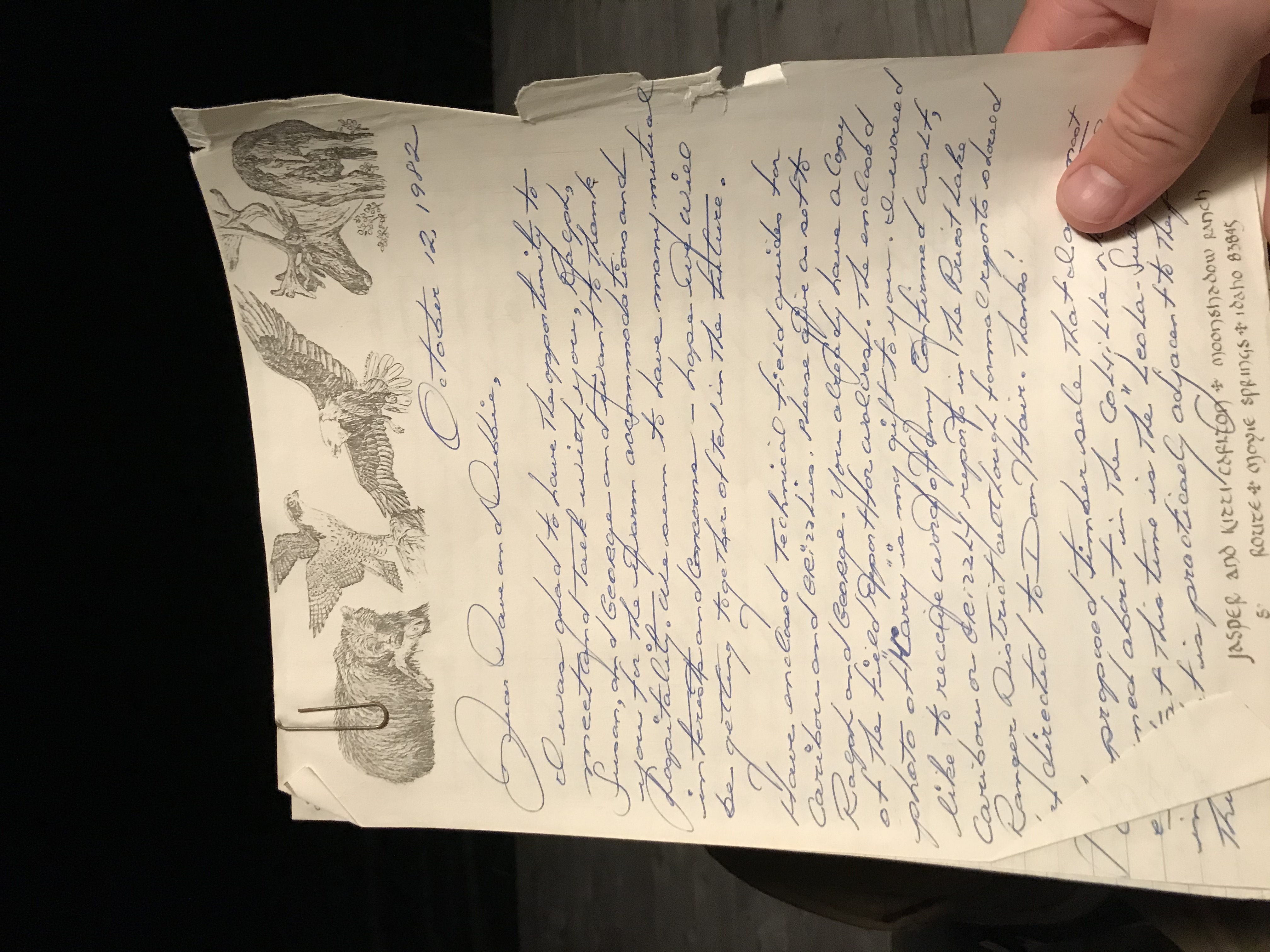
We move to a larger cabin built by Dave and his brothers. The interior is dusky, storybook, and smells lushly of cedar. The camera recording, Dave becomes uncharacteristically demure about his own encounter with mountain caribou, which in fact never took place. Chris and I make a dent in our bottle of whiskey. Dave takes a big gulp of wine. As I told him over the phone, we are interested in precisely what you didn’t see and how that felt. He looks at Phil. Phil, however, looks at me and I realize we’ve got Dave where we want him. He is getting ready to sing.
“Phil, I told you these guys were crazy.”
Dave tells the story of how for ten years he tried and failed to see a black caribou in the wild. I will not relate his story here because it is too long, but also because the timbre and eloquence of Dave’s voice, like Bob’s, deserves to be heard rather than read—and can be heard, on our deep map. Suffice to say: A decade of going up and down the gnashing serrated teeth of the Selkirk crest on snowshoes. But to no avail. He saw tracks but never the ghost itself. Chris asks him what he thinks it would have been like to see a caribou. Dave smiles.
“What it would have been like to see a black caribou in the old growth spruce forest on top of the Selkrik crest? If you were agnostic you’d reconsider because God has just exposed his face to you…or a glimpse of his face.”
We lose the light and decide to film the same session again in the morning. We move back over to the first cabin and drink more beer as Dave prepares a stir fry dinner. Short on rice, Dave mixes jasmine and basmati together, which cooks unevenly and gets stuck in our teeth. Chris thanks Dave for the “Bosmati” rice which draws a laugh from everybody, even Phil.
“Hey,” says Dave, “You guys wanna see the Jeannot caribou?”
Phil yanked open the cellar door and gestured for us to enter like a maître d’ pointing to our table. I see Chris hesitate at the foot of the bulkhead. Ducking his head under a crossbeam, Dave senses the hold up and says, “Come on man! If I go in here alone there might be a fuckin’ angry bobcat or something!” Then Phil comes down the stairs. The basement is illuminated by a single overhead lamp which casts an orange hue on everything. We’re all standing in front of a washer and dryer. On top of the washer sits a caribou shoulder mount-sized object covered by a black trash bag.
“Phil, why you don’t you go ahead…”
And then we saw the Jeannot caribou. I don’t know how to describe the scene that followed except to say we encountered the Jeannot caribou. It was the worst example of taxidermy I had ever seen. It was a hay-stuffed sock puppet caribou with gouges in its head where the antlers had been hacked off by juvenile delinquents. Instead of the dark and depthless shadow cast by old growth canopy, the Jeannot caribou was the color of a Ritz Cracker. The frayed skin flap of the lower jaw had completely detached, and Phil was using it to make the caribou talk like some profane and dilapidated Muppet.
“You guys want some caribou hair? It’s hollow. It’s so buoyant they used it to make life jackets in the first world war.”
Dave gives us each a pinch of formaldehyde-stained Jeannot caribou hair. I place mine in my breast pocket where the stiff follicles begin to poke through the fabric and irritate my skin. My mind goes to the sinking of the Lusitania and I picture the survivors bobbing in the cold Atlantic in life jackets made from dead caribou. Then Dave has Phil mercifully place the Jeannot caribou back in its trash bag. Chris and I go up for air. We need it.
We emerge to twilit skies. I feel the bowl of the meadow and its million buzzing insects begin to slowly tilt as I realize how drunk I am. Dave and Phil make their way to bed. We pour ourselves a Scotch from Dave’s liquor cabinet and find our way to the porch, which I promptly fall off into the soft grass. Neither of us knows what to make of what just happened, other than it being an encounter. Whether the encounter was with a caribou or human or something in between is uncertain. I begin to laugh thinking about the face of god before realizing I have no idea what the face of god looks like.
Later that night, in the star-studded vortex of our drunkenness, we spot a curious object in the heavens. It was like a star except blurry and more massive in size, and this blurriness, we had established, was not our fault but in fact due to the object being covered in a kind of luminous mold, making it brighter than any other in the sky. Strangest of all, it had a tail. Then it dawned on me: it was the comet from my Instagram feed—Comet NEOWISE. Looking back now, I realize: If only we had been able to snatch the comet’s tail and bury it, still twitching, in my father’s rose garden high up on Little Snowy Top where the last caribou in the South Selkirk mountains made its home, they would come back for us. But I was too drunk to stand on Chris’s shoulders and the opportunity was missed.
Are there mountain caribou in the South Selkirk mountains of Idaho right now?
Arise Lazarus.
